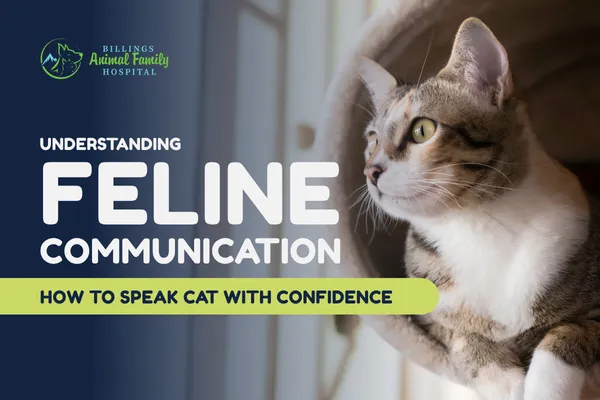
Feline Communication: How Cats Talk | Billings Animal Family Hospital
Understanding Feline Communication: How To Speak Cat With Confidence
Ever felt your cat’s enigmatic meow or tail flick is a message you can’t decode? Cats are skilled at using vocalizations and body language to express emotions, but most humans struggle to understand “cat speak.” With insight, you can unravel these feline communication signals and strengthen your bond.
Cats communicate with varied meows, purrs, and chirps, using tone and body language like high tails or flattened ears to express greetings, demands, or moods. Scent-marking by rubbing claims you, adding depth to their signals. Decoding these cues reveals their unique, meaningful conversations.
What You'll Find In This Post . . .
Understanding Feline Communication: How To Speak Cat With Confidence
Build a stronger bond with your cat through feline communication
Vocal communication
Vocalizations that your cat may make are the easiest cues to interpret. Some cat breeds are much more talkative than others. The Siamese and Oriental shorthair are known for their lengthy conversations. Learn these “words” in the feline language.
Meows
This noise is reserved solely for human interaction. While kittens meow to their mothers, adult cats usually only meow to people. Cats learned that humans do what they want when they meow, whether it’s providing more food, doling out attention, or picking up their dead mouse.
Yowl
Similar in sound to a meow, a yowl is more drawn out and musical. You may hear this caterwauling when tomcats are fighting over female companions.
Chirp
Used by mother cats to tell their kittens to follow, this sound is often employed to entice you to follow your cat to her empty food dish. Cats also tend to converse with one another in this manner.
Purr
Often an indication of contentment heard during mealtimes and petting, purring may also signify that a cat is anxious or ill. This magical sound has also been shown to help heal bones, muscles, and tendons, as its frequency is conducive for tissue repair and wound healing. Not only is a purr a sign of happiness, but it can also soothe and heal both you and your cat.
Growl, hiss, or spit
These vocal cues need no explanation. If you hear any of these sounds, watch out!
Body language cues
A little more difficult to interpret, body language signals hold the most meaning in feline communication. To fully understand your mysterious pet, study up on these postures and positions that will clue you in to how your cat is feeling.
Tail position or motion
A fully erect tail signals a greeting, or a request for food or attention.
A fluffed tail means beware, regardless of position. An arched tail indicates a cat is torn between being aggressive or defensive, while a fluffed tail pointed down or straight out signals aggression.
A flicking tail is a sign that a cat is losing patience and is becoming irritated. Veterinary team members understand this tail cue to mean it’s time to wrap things up.
A swishing tail is a step beyond a flicking tail. This usually signals that a fight is about to break out between two cats or that chaos is about to occur.
A tail that is wrapped around a cat’s body may mean that she is content, or may demonstrate anxiety in a nervous cat.
A tail that is held down is commonly seen with an arched rump, indicating aggression toward another cat.
Eye signals
The slow blink is a powerful communication device in the feline world, signifying reassurance. If your cat gives you a long, slow blink, consider it the ultimate compliment, as she is saying that she trusts you.
The continuous, hard stare has the opposite effect, used to threaten and unsettle feline opponents in territorial battles.
Dilation of the pupils is commonly seen in the defensive cat, providing her with a wider field of vision.
Constriction of the pupils helps an aggressive cat in attack mode by strengthening depth perception.
Ear position
Forward-pointing ears indicate a confident, curious cat.
Ears flattened for protection signal a defensive posture.
Flattened, but forward-pointing ears indicate the aggressor between two cats.
Body posture
An arched back with fluffed-out fur means you need to be cautious—this signals a frightened or upset cat.
An arched back with flat fur is a much more welcoming pose, indicating your cat would enjoy some attention.
Lying on her back while purring or kneading the air is the picture of contentment in a cat.
Lying on her back while growling with flattened ears signifies that a cat is ready to defend herself. This position allows her to utilize her powerful hind legs and claws.
Tactile communication
Another type of feline communication is physical touch. Cats touch not just to show affection, but also to create social bonds, mark territory, and communicate comfort or stress. These gestures are often overlooked, but they speak volumes in cat communication.
Head bunting (or headbutting): When your cat gently bumps their head against you, it's a way of marking you with their scent and expressing affection.
Kneading (or “making biscuits”): Pressing their paws alternately into soft surfaces (like your lap or a blanket) stems from kittenhood when they kneaded their mother's belly to stimulate milk flow. As adults, it indicates comfort, trust, and contentment.
Allogrooming (mutual grooming): Cats lick or groom each other and sometimes their humans to reinforce social bonds and show acceptance into their “clan.”
Rubbing against legs or objects: A cat winding around your legs or rubbing on furniture isn’t just being cute. They’re spreading their scent to claim territory and communicate safety.
Gentle paw touches or taps: Your cat might place a paw on you to get your attention or express affection. It’s a polite “Hey, human.”
Sleeping on you or near you: Physical closeness is a strong indicator of trust. When a cat chooses to nap in your lap or by your side, it’s a powerful message of comfort and connection.
These tactile signals help cats communicate trust, affection, ownership, and even a sense of security. The more your cat initiates touch, the stronger your bond likely is.
Olfactory communication
Scent is one of the most essential and underappreciated feline communication. With their powerful sense of smell and scent glands located across their body, cats mark the world and their people with invisible messages.
Cheek rubbing: Cats have scent glands on their cheeks. When they rub their face on you, furniture, or doorways, they’re depositing pheromones that say, “This is mine and it’s safe.”
Paw pads: Cats also have scent glands in their paws. When they scratch surfaces (even if it’s your couch), they’re marking territory with both visual marks and scent.
Tail base and flank rubbing: These glands are used to reinforce their scent on objects or people they trust. If your cat turns and presses their side or rear against you, it’s a social bonding gesture.
Scent swapping with other cats: Cats in multi-cat households may rub against each other to create a shared group scent, which reduces conflict and promotes harmony.
Sniffing as information-gathering: Cats gather information by smelling everything. This helps them assess safety, ownership, or whether another animal has been in the area.
Even their whiskers, while not scent-related, help them navigate and “map” the world with precision, adding a tactile layer to their sensory experience.
Build a stronger bond with your cat through feline communication
Learning to “speak cat” isn’t just a party trick, it’s one of the most rewarding parts of being a cat parent. When you understand your feline friend’s body language, sounds, and signals, you reduce stress and strengthen your connection.
Observe. Listen. Learn. Celebrate every “aha!” moment when you finally nail the meaning of that tail flick or meow marathon.
If your cat seems to be signaling pain, anxiety, or behavioral changes, don’t ignore the signs. They’re communicating that something isn’t right. Book a consultation with us to get expert guidance and give your feline friend the care they deserve.



